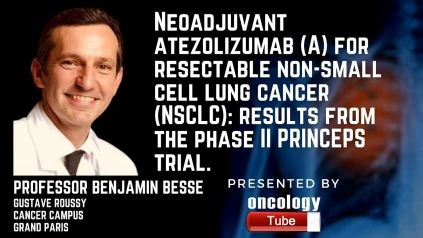Professor Benjamin Besse from the Gustave Roussy Cancer Campus Grand Paris and University Paris-Saclay discusses the ESMO 2020 Abstract Neoadjuvant atezolizumab (A) for resectable non-small cell lung cancer (NSCLC): results from the phase II PRINCEPS trial.
Abstract 1215O
Context
In 17-45% of NSCLCs, neoadjuvant immune checkpoint inhibitors induce major pathologic response (MPR) rates. We are announcing the findings of a neoadjuvant A phase 2 trial for NSCLC.
Methodology
Patients (pts) with clinical stage IA (⇠2 cm)-IIIA non N2 NSCLC eligible for surgery, PS 0-1, obtained 1 A (1200 mg IV D1) injection accompanied by D21-D28 surgery. The primary endpoint was the rate of pts from D1 up to 1 month after the surgery without significant toxicities or morbidities. Within 4 hours after surgery, fresh tumour tissue was examined. Response by RECIST1.1 and substantial pathological response (MPR; ~10% viable tumor) were evaluated.
Outcomes
30 pts is enrolled in two centres from December 2016 to February 2020. The mean age of pts was 64, 50% were female, 7% never smoked, 83% had adenocarcinomas. I (n=15, 50 percent), II (n=6, 20 percent), III (n=9, 30 percent) were the pathological stages. All pts had their scheduled surgery, none were > 15 days overdue. 29 had resection R0, and 1 had resection R1. Three pts had surgical complications: 1 grade 3 respiratory distress with sepsis grade 4, 1 atrioventricular heart block, and 1 grade 1. paresthesia. Grade 5 toxicity did not occur. Only one grade 1 parietal pain related to surgery was included in the treatment-related adverse effects (TRAEs). No radiological response from RECIST and no MPR was observed. After A, based on the SP142 assay, 15/29 tumours were PD-L1 TC3 or IC3. There was necrosis of 17/30 (56 percent) tumours (med. 5 percent of tumour surface, 0-80). Histopathological response characteristics according to the immune-related pathological response criteria (irPRC) were 20/29 cases, with isolated or combined immune activation (19/20), tissue repair (15/20), and/or tumor cell death (9/20) characteristics. NGS (11 genes) was performed in 23 tumors resulting in 14 TP53 mutations (mut), 7 KRAS mutations, 3 EGFR mutations, 1 wild-type, 1 STK11 mutation (t mutation), 7 KRAS mutations, 1 wild-type, 1 STK11 mutation (t mutation t).
Findings
It was healthy to have surgery after one A infusion. The lack of MPR could be clarified by the brief delay between A and surgery.
Identification of Clinical Trial
NCT’s02994576.

